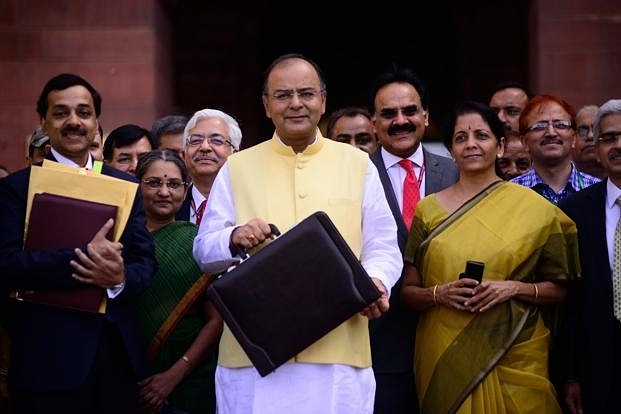
Devolution Of Funds To Local Govts - Budget 2016 Reflects A Shift In Policy Thinking
A welcome shift in the way welfare expenditure is planned
“A sum of ₹ 2.87 lakh crore will be given as Grant-in-Aid to Gram Panchayats and Municipalities as per the recommendations of the 14th Finance Commission. This is a quantum jump of 228% compared to the previous five-year period. The funds now allocated, translate to an average assistance of over ₹ 80 lakh per Gram Panchayat and over ₹ 21 crore per Urban Local Body. These enhanced allocations are capable of transforming villages and small towns. Ministry of Panchayati Raj will work with the States and evolve guidelines to actualize this.”
The Finance Minister of India, while presenting the union budget for financial year 2016-17, used so many words to allocate almost $42 billion to the local governments (LGs) in the country. To put it in perspective, the allocation is slightly more than the total outlays for roads and railways in the coming fiscal year. The amount is also roughly equivalent to the GDPs of countries like Panama, Tanzania, and Lebanon. This is in addition to the numerous other grants such as MNREGA, LAD funds, etc.
This allocation is a welcome shift in the way welfare expenditure is planned in India.
In the matters of governance, the LGs play a most important role in one’s day-to-day life. Around the world, They are responsible for services like water, roads, street lighting, and other public amenities. However, in popular discourse and commentary on politics, local governance does not find the attention it deserves. By giving an unprecedented sum of public money to the LGs, the union government has infused the village and city governments with autonomy as well as accountability.
The grants recommended by the Fourteenth Finance Commission (FCC), on which the allocation is based, call for the LGs to provide basic services such as sanitation, drinking water, maintenance of community assets, solid waste management, and others. More than a two-third of Indians live in villages, which are governed by gram panchayats (village councils). ₹80 lakh per year (nearly $120,000) for a typical constituency of 3,000 people is a significant resource to construct roads, put street lights, and to provide other similar amenities. The FCC even recommends the use of LED lights for street-lighting. As the minister says, the proposed financial assistance can be transformational.
A noteworthy difference between these grants and others is that these grants-in-aid are largely flexible in the way they should be spent. With the basic guidelines as mentioned above, it is for the local policy makers to decide what their constituency needs maximum resources for. Therefore, it provides for careful analysis together with creativity at the local level.
Further, the FCC recommends one-tenth of the grants to be performance-based. To be eligible for these grants, the LGs should provide audited accounts from previous years and demonstrate that it increased its own revenues. Therefore, the grant comes in the form of a reward for doing well rather than an aid to cover a failure. This is an incentive for the LGs to reinvent and become more accountable.
The increased allocations also come with a risk. The level of scrutiny - both in the courts and in the media - that the local governments in India undergo is far from desirable. On top if this, citizens’ apathy towards local governments and a lack of mechanisms to bring accountability in the councils lead to an inefficient resource management. In such a case, corruption does not just go unreported, but also unnoticed or even accepted as norm. The union and state governments should advocate for substantial reforms to make the LGs more accountable and citizen-friendly. Performance management, participative decision making, transparency and the use of data are just some of the tools LGs can use to build a more responsible local governance capacity in the country.
If the higher levels of governance can make the local level more responsible, and the LGs use the increased allocations smartly, Indians can hope to experience a radical shift in their local environment. The impetus now should be to achieve coherence in the multitude of grants and schemes operating at local levels. The planned increase in grants to LGs should be seen in tandem with other provisions such as the adarsh graam yojana (model village scheme), Local Area Development funds, rurban mission, welfare expenditure on health and education, public distribution system and much more.
The center, the states, and the LGs, along with their various departments must create an environment for a smooth flow of information, decisions, and funds. One key factor in this process will be the guidelines that the Ministry of Panchayati Raj and the states deliberate upon regarding these grants. In the current policy environment, India is witnessing a significant financial devolution to the states. In the current political environment, on the other hand, the ruling alliance at the center is encountering strong state-rivals. Overlooking political rivalry and embracing devolution, it will be up to the sane minds in the system to comprehend the benefits that fiscally strong and autonomous local governments bring with them. With a cobweb of government departments and a tendency to get stuck in paper work, the task to achieve coherence looks difficult. However, it is necessary if the government’s agenda is to see the light of day.
Sahil is a public policy professional and co-founder of Vision India Foundation. He has studied at IIT Delhi, Jindal Global University, and Indiana University Bloomington.